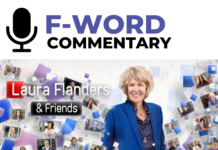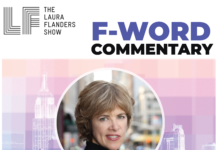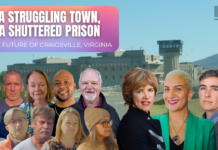Prefer to Listen?
Subscribe to our podcast to listen to this week’s episode on your favorite podcast platform (Available 7/31).
Affirmative action’s foes worked with conservative Chinese American organizations to sue two colleges over their admissions processes. The result was a victory for activists who have been trying to do away with affirmative action for years. What led to the June 29 decision by the Trump-packed Supreme Court finally to ban race-conscious affirmative action? In this month’s “Meet the BIPOC Press” feature with URL Media, our guests fill in the blanks in the media coverage and correct some of the misconceptions about affirmative action, systemic racism, and how we got here. This time, Laura Flanders and co-host Sara Lomax of Philadelphia’s WURD Radio are joined by Washington DC-based journalist Brandon Tensley, the National Politics Reporter at Capital B News, a nonprofit newsroom based in Atlanta, and Claire Jean Kim, a political scientist and Asian American studies professor at UC Irvine in Southern California. Kim is also the author of the forthcoming book “Asian Americans in an Anti-Black World”. How will the recent Supreme Court decision affect diversity and fairness in US institutions, and what does solidarity with African Americans specifically look like in the US today?
“As someone who teaches about anti-Blackness and race, I can tell you how much that impacts the classroom to not have more diversity in the classroom . . . It affects the quality of education for everybody.” – Claire Jean Kim
“We are destined to repeat horrible mistakes by pretending that race doesn’t matter . . . I think we are foolish to think that this decision or any of these decisions are going to move us forward.” – Sara Lomax
“One of the professors I spoke to put it very clearly when I asked him, ‘What will the higher education landscape look like post affirmative action?’ He was like, we don’t need to theorize, we don’t need to sort of imagine it. We can look to where this has already happened . . . “ – Brandon Tensley
Guests:
- Claire Jean Kim: Professor of Political Science & Asian American Studies, UC Irvine; Author, Asian Americans in an Anti-Black World (Cambridge University Press, 2023)
- Sara Lomax: Co-Founder, URL Media; President & CEO, WURD Radio
- Brandon Tensley: National Politics Reporter, Capital B News
Transcript
THE LAURA FLANDERS SHOW
Asian Americans & Anti-Blackness: Truth vs. Fiction on Affirmative Action
LAURA FLANDERS: The Supreme Court decision of June 29th, gutting affirmative action has upended the college admissions process, and left lingering questions for US universities, businesses, and society at large. The decision reversed decades of Supreme Court precedent that acknowledged racial inequality and sought to remedy it. At the center of the case was the University of North Carolina, once itself a bedrock of Jim Crow segregation, and Harvard University, one of the nation’s most elite institutions. As institutions, each acknowledged race among dozens of other factors in their admissions processes, so as to evaluate students for their merits and for the good of the student body as a whole. Suing was conservative activist Edward Blum who has filed over two dozen cases since the 1990s attempting to strip the concept of race from America’s laws. Eight of his cases have gone to the Supreme Court. Finally, this term, the court’s conservative super majority stacked with three Trump appointees ruled in favor of Blum and his group Students for Fair Admissions. Supporters of the decision called it a victory for colorblindness. Others are aghast, and for all the oceans of printing and hours of talk about this case and others that preceded it, many key issues around affirmative action have been missed or confused. For this month’s ‘Meet the BIPOC Press’ with URL Media, we’re going to take a closer look. I’m joined once again by Sara Lomax of Philadelphia’s WURD Radio. She’s co-founder of URL Media, a network of independent media outlets owned and operated by people of color. Joining us are Washington DC based journalist Brandon Tensley, the National Politics Reporter at Capital B News, which is a nonprofit newsroom based in Atlanta. And Claire Jean Kim, a political scientist and Asian American studies professor at UC Irvine in Southern California. Her book is about to come out, titled Asian Americans in an Anti-Black World. I for one, can’t wait. Welcome all. Brandon, I think I’ll start with you. Let’s talk about media hits and misses. What have you seen out there?
BRANDON TENSLEY: Yeah, I think one of the things that sort of struck me about the framing that I’ve seen around this latest Supreme Court decision is there seems to be a greater embrace, I would say on the part of people in the media to really scrutinize the way that we framed these issues before.
LAURA FLANDERS: Typically to give some background, the media in this country, white-dominated, have been very good at talking about racism as something that individuals do, less good at looking at systems. It’s also been super receptive to right-wing frames like the ones I just mentioned: colorblindness, race consciousness.
BRANDON TENSLEY: Colorblindness or race neutrality is a term or these are terms that have been sort of batted around for decades now and often have this sort of sheen of neutrality, of causing no harm, those sorts of things. But at least from the coverage that I’ve seen, and certainly the way that we’ve been covering it at Capital B is talking with people about what do these terms actually mean? What do they entail, and what have been the consequences in the past? Can you really get to the level of diversity that you want when it comes to racial diversity without actually considering race, by taking a race neutral approach? And I think this has been a huge improvement from the way that people in the media have covered these sorts of issues in the past, by not just sort of wholeheartedly sort of embracing the framings that we get from Supreme Court opinions, from various sort of conservative activists, but really rigorously asking, what do these terms mean and what has been the effect of these kinds of policies in the past?
LAURA FLANDERS: Yeah, so some progress, but clearly not enough. What have you been making of it all, Sara?
SARA LOMAX: One of the things that I think has not been discussed enough is the fact that in this Supreme Court decision, it was an Asian American conversation, and there were plaintiffs who were saying that there was kind of reverse discrimination against Asian students and that was different I thought. And I don’t know if we’ve covered enough about this kind of people of color dimension of this case and what it means for the relationship between Asians and Blacks.
CLAIRE JEAN KIM: Thank you for raising that issue, Sara. For me, that’s the issue that has been least addressed by the media in the postmortems of the case. So yes, in this case it was Ed Blum who was at the front of the case. But all of the plaintiffs in the case were Asian American students. East Asian students that Blum deliberately recruited because he knew Asian American students would provide a more sympathetic figure, right, for the court to look at and say, well, if Asian Americans have been discriminated against, how can we burden them with affirmative action and to help other racialized groups? So it’s a very troubling entrance of Asian Americans into national politics. My argument in my book is that Asian Americans have been positioned differently in the US racial order than Black people. They have been seen as not white, but above all, not Black. And that has given led to a certain kind of structural advantage, which in turn has led to whites in America using Asian Americans as a way of proving their anti-racist bonafides without having to help Black people, without having to address structural anti-Blackness. So this dynamic has actually been around, I would argue, for more than a century. Clearly, we can see it during World War II. This is just sort of the latest instantiation of that historical patterns.
LAURA FLANDERS: So who was it that Edward Blum worked with specifically? And you’ve written about this too. I mean, he was part of the Texas case that put forward a white woman, I think Abigail Fisher, when that failed, he was quoted as saying we need Asian plaintiffs. Who did he find?
CLAIRE JEAN KIM: He found a number of East Asian students ranging from different backgrounds. But the key players that I want to highlight who were involved in sort of the background of this case helping to support Blum’s efforts were conservative, affluent Chinese immigrant organizations. And these have sprung up in the last 20 or so years, 20 to 25 years. And they’re incredibly well-resourced, highly educated people who have been very powerful, very outspoken players on the national stage. And I’m not sure the media is getting this, making enough of the story that this is a convergence between white conservatives and Chinese American conservatives.
LAURA FLANDERS: Up until the middle of the nineties, I remember seeing Asian Americans out there protesting for affirmative action in US universities. That story seems to have been sort of lost in the coverage now.
CLAIRE JEAN KIM: It’s a complicated multi-level, multi-layered history with affirmative action. But certainly the main national advocacy organizations for Asian Americans such as Asian Americans Advancing Justice, they take a strong consistent pro affirmative action stance on the grounds that affirmative action helps Asian Americans as well as other groups.
SARA LOMAX: I want to come to you, Brandon, you wrote a really powerful article in Capital B called the US Supreme Court Seems Ready to Gut Affirmative Action, and we know what happened. And I want to see if you could tell us a little bit about some of the strategies that you discussed in that article and where we go from here. Like what is the roadmap forward when we see these kind of rollbacks?
BRANDON TENSLEY: Right, so a lot of the experts I talked to for that specific story, they talked about the way forward would include probably these sort of mechanisms of race neutrality, right? So if you look at states that have gotten rid of affirmative action in the past, and I believe there are nine states. The enrollment of students of color specifically as some of the larger sort of flagship universities in these states, took a hit. They have not really been able to get to the level of diversity that they had before banning affirmative action. And so one of the professors I spoke to put it very clearly when I asked him, I was like you know what, what will the higher education landscape look like post affirmative action? He was like, “Well we don’t need to theorize, we don’t need to sort of imagine it. We can look to where this has already happened to get a glimpse of what’s in store on a much wider scale.”
CLAIRE JEAN KIM: Right, so California in the 1990s and the UC system in particular did away with affirmative action. And we now have approximately, I think 3% Black enrollment at UCI in the undergraduate population. And as someone who teaches about anti-Blackness and race, I can tell you how much that impacts the classroom to not have more diversity in the classroom, to have primarily white and Asian students in the classroom. There’s some diversity in the sense that there are Asian American students, but that does not make up for the extreme lack of diversity when it comes to Black students. So it affects the quality of education for everybody.
SARA LOMAX: We know that anti-Black racism shows up in communities of color, it’s not just about white and Black, we see it in Asian communities and Latino communities, et cetera, because there really is a caste system, a racial caste system in this country. And from Black people, I get this effort around people of color as opposed to Blackness is really problematic because there is racism, and there is alignment with white supremacy in communities of color outside of the Black community. I know that we want solidarity, but it is a very fraught conversation when you really look at the dissension or the difficulties between Black and Asian communities.
CLAIRE JEAN KIM: We talk a lot about solidarity among peoples of color on the left side or the progressive side of the spectrum. But I think it’s happening on the right side of the spectrum and we’re not paying enough attention to that. And Asian Americans are positioned structurally differently than Black people. And I think if we go in my book, I go back to the movement era, the sixties and say, why was it Asian American activists were often not taken as seriously by Black activists, let’s say, because Black activists perceive them as being structurally positioned differently. And there are many ways we can look at that. For example, the most obvious example would be the underrepresentation of Asian Americans in mass incarceration, in carceral institutions. And the way that we are not subjected to over policing in the same way that Black people are.
LAURA FLANDERS: So what would effective solidarity look like, in your view, Claire?
CLAIRE JEAN KIM: I think effective solidarity has to be something along the lines of Asians for Black Lives, that group, any organization that names an Asian American-ness, but centers anti-Blackness in the analysis and says Asian Americans, yes, are discriminated against in many ways. And we can’t dismiss all of the concerns that the plaintiffs in the Harvard and UNC cases raised. But at the same time, that experience of discrimination is not of the same magnitude as the experiences that Black people have gone through and continue to go through. So Asian American politics needs to center anti-Blackness in its analysis and in its struggle. I think that’s this move towards solidarity that we can make.
BRANDON TENSLEY: I think Claire’s spot on, and this is I think a perfect distillation of, often when we talk about solidarity movements, we’re talking about people on the left, myself included when I think about even that term, solidarity movement, I’m going to civil rights movements, the Black Lives Matter movement, all of which I think do have those elements of sort of multicultural, multiracial solidarity, but also really paying really important attention to how solidarity also plays out more on the conservative end of the spectrum I think is just a really fantastic point.
LAURA FLANDERS: It seems like solidarity has taken a kind of “me too” form. We’re discriminated just like you, and hence our solidarity. What I think I’m hearing from Claire is we need a kind of “we also, but you especially” form of solidarity is that more or less right?
CLAIRE JEAN KIM: I think that’s right. And this is going to come up again, it is coming up again now with the California reparations issue, right? With the reparations commission in California now recommending various forms of reparation. And it’s a big question whether Latinx and Asian American legislators will support this bill. So it will raise all kinds of questions about comparative desert, and about the relative experiences of these groups.
SARA LOMAX: I did want to ask you, Brandon, because one of the things that keeps coming up in the aftermath of affirmative action is that HBCUs, Historically Black Colleges And Universities, are going to see a surge in enrollment, and they’re going to be empowered in a way that we haven’t seen in the past. And I’m curious in your reporting, and as you’re talking to folks, what are you hearing about the impact on historically Black colleges and universities as maybe an unintended positive consequence in the aftermath of this decision?
BRANDON TENSLEY: A lot of people are talking now about not only the importance of potentially attending HBCUs, but if Black students are going to see, they’re going to see the appeal of attending HBCUs more now, then we should also be funding HBCUs more. And so I think those two things are a really important sort of next phase of this conversation or current phase of the conversation is how do HBCUs fit in this, how do they fit into college, to high school students, college applicants plans for higher education?
LAURA FLANDERS: And I hate to ask this of you Claire, but how do HBCUs fit into the conservative right agenda? I mean, hesitate to ask for fear of the answer, but it’s also true that people like Edward Blum, Edward Blum specifically have been involved in all sorts of attacks setting back civil rights, going back to Shelby v Holder on the voting rights side.
CLAIRE JEAN KIM: The efforts by Blum in education, the efforts by Blum in voting rights, and the efforts at state and local levels to restrict curricula, that’s all tied together. I mean, as an educator, I know if my students have not been exposed to the US history, and I asked them, I asked them this quarter, I said, how many of you feel you have gotten in K through 12 in the US, an adequate understanding of the Black experience and slavery? Not one person out of 170 in that class raised their hand. So if the students are not getting that education even when so-called critical race theory has been permitted to be taught, then what is going to happen when we have public policy decisions like affirmative action or reparations which call upon us to understand that history, so that we can improve this society, and make it work better and be more fair. And we can’t do that without that historical knowledge. And it’s no accident that people on the right are going after curricula, and trying to intimidate educators from talking honestly about race and racism and anti-Blackness in US history. Because if people know about it, they’re going to be a lot more sympathetic to things like affirmative action and reparations.
LAURA FLANDERS: It comes back again to what everyone is sort of tussling with here, which is sort of the all in the same boat approach versus not the same. How do we get at this, and particularly in the media, are there people that you see, or outlets that you see that are doing this particularly well? Sara, maybe from the URL Media network?
SARA LOMAX: What URL is attempting to do, we’re only two years in, but we are a network of Black and Brown owned and run media organizations that come together to share content, share revenues, to create more sustainability. I think that we are attempting to have real conversations about our differences and what it would look like if we were able to create solidarity across different communities of color which would be the majority of this country if we were able to create real authentic connections. I think that the conservative right, that’s their biggest fear is that we would be able to actually coalesce around issues and mobilize to change politics and social issues and all of those things. But there’s so much underneath, anti-Black racism is real, and it’s rooted in I think every racial group that is here in this country and abroad.
LAURA FLANDERS: And it leaves lots of fissures for the right to exploit, Brandon, what’s this story looking like in the reporting of it looking like there at Capital B?
BRANDON TENSLEY: There was a a story that I did a few weeks ago around the 4th of July, looking at white nationalism, looking at patriotism, again, looking at how so many of these different attacks that we’re seeing are tied together. And I remember the professor I talked to, Omar Wasow, he’s a political scientist at Berkeley. And we talked about how the attacks on trans people are connected with the white nationalist attacks, are tied to the attacks on books, are tied to the attacks on Critical Race Theory. about that conversation to get about that conversation to get to your more immediate question is it really made me, made us, made our readers sort of take this wider lens to these issues. You can’t really talk about anything that’s happening in terms of far right attacks today, you can’t really understand it without taking that much wider lens. At the end of the day, this is about creating, bolstering, returning to a very rigid and narrow social order, social hierarchy that everyone has a very specific place in.
SARA LOMAX: Claire, I want to ask you about kind of the slippery slope aspect of this affirmative action decision because we’re now seeing conversations around eliminating diversity, equity, and inclusion in corporations, and set asides for small businesses that were quote unquote “disadvantaged”.
CLAIRE JEAN KIM: I think this very much ties into what Brandon was saying about January 6th, white nationalism, right? The idea of Make America Great Again. When was it great? I mean, in the view of these people it was great maybe in the 1950s during Jim Crow, before the women’s movement, before the gay rights movement. So this is very much an attempt to roll back or move forward into a different kind of space than we’ve had in some ways. But in many ways that is still a return to the retrograde politics of the past. So there is, I think, a real danger here. It’s not just going to affect higher education, this case is going to lead to other, with this super majority in the court, going to lead to the end of affirmative action I would think in many other areas. Ironically, corporate leaders, they don’t want diversity and inclusion programs to end because they see that those programs actually make their workplaces work better. People work better under those conditions, they learn more, their companies operate more efficiently in the global market. So ironically, it’s the business leaders telling us, we actually need these programs still. What is the counter punch on the left? Who’s coming back on this? In terms of institutional politics? It’s hard to see that, the Democratic party, in my view, doesn’t provide a strong voice on race issues, on racial justice issues.
LAURA FLANDERS: It’s important as you just reminded us, Claire, to remember that Ed Blum doesn’t work alone, doesn’t operate alone. Some of the media have made you think that it’s just him out there, crusader extraordinaire. Likewise, the pushback is a collective one, and media are going to play a big part of it. Media played a huge role in shifting the narrative thus far and shifting attitudes towards affirmative action and race and racism and what we do and what works and for whom. Brandon, I’m throwing this to you. What’s the role of the media next, and how do you embrace, or determine your own role in this?
BRANDON TENSLEY: I think one thing that I really focus on is the follow through on these stories. Students who are looking at applying to college now, like, okay let’s follow up with them next year. Let’s talk with educators. As we get into 2024 about how have issues changed even over the past like two years since the midterms, but really having a sort of consistent view or interrogation of how these issues are playing out is something that we try to do at Capital B. I’ve been doing a lot of reporting about what’s happening in North Carolina, a state that I think minus the affirmative action case, can sometimes get overlooked when we’re thinking about sort of the state of racial politics in the US today. And so for me, I think it’s important to not just be like, oh no, the North Carolina Supreme Court in April sort of went back on two decisions that the Democratic led North Carolina Supreme Court last year made, but actually look at, okay they said that they’re going to do this or they sort of gave the green light for this particular policy. When it goes into effect in August, we need to talk with people about, okay, how is this impacting people’s real lives? What are people actually doing on the ground to push back against these efforts? Really tying together, how do these affect people in a much more sort of structural way. This isn’t just a one-off decision, a one-off day in the news, but for people who have to live through these decisions, the after effects of these decisions, what does that look like?
LAURA FLANDERS: So important what you said, Brandon. Any final thoughts from you, Sara? I know you live and breathe this stuff there at WURD.
SARA LOMAX: What I keep seeing over and over again is that this country cannot look at its history directly in its face and understand that at its core there are some very cancerous elements that have to be addressed. And I feel like we are destined to continue to repeat these horrible mistakes by pretending that race doesn’t matter, and it wasn’t that big of a deal. Slavery wasn’t that big of a deal and redlining didn’t matter and all of these things that were institutionalized to consistently disempower Black people in this country, I think we are foolish to think that this decision or any of these decisions are going to move us forward. And until we can actually address the racist history of this country, we are never going to be the fullness and the greatness that we should be. And I just think that we have to keep fighting, it’s incumbent upon all of us to just slog it out. There’s no other choice.
LAURA FLANDERS: I can hear a new program, Complexity Now. Something like that. Sara Lomax, thank you so much. Brandon Tensley, Claire Jean Kim, it’s been great talking with you. We’ll do more on this and if you want to see our multi-part series on North Carolina, just go to our website for the Laura Flanders Show. Thanks so much for being with us for this special feature, ‘Meet the BIPOC Press’ with URL Media.
For more on this episode and other forward-thinking content, subscribe to our free newsletter for updates, my commentaries, and our full uncut conversations. We also have a podcast, it’s all at lauraflanders.org.
Related Episodes, Articles and More
Head to our Patreon for a list of related episodes and articles. And check out all episodes in our series Politics and Society playlist on YouTube.
Accessibility
The Laura Flanders Show is committed to making our programming, website and social media as accessible as possible to everyone, including those with visual, hearing, cognitive and motor impairments. We’re constantly working towards improving the accessibility of our content to ensure we provide equal access to all. If you would like to request accessibility-related assistance, report any accessibility problems, or request any information in accessible alternative formats, please contact us.
















